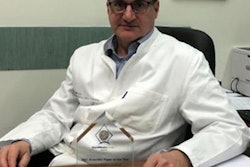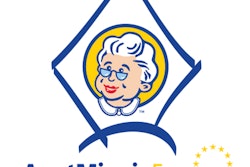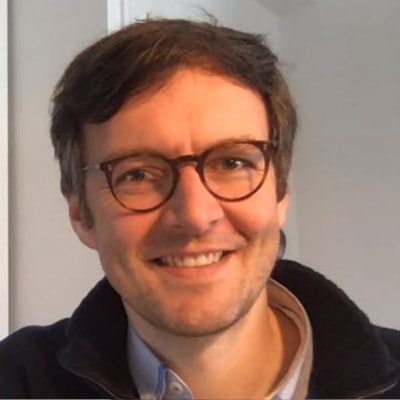
Companies have had to adjust fast to a whole new way of working since governments imposed lockdowns across Europe. In an exclusive interview, radiologist and industry boss Prof. Dr. Wieland Sommer describes how his firm has adapted during the COVID-19 crisis and how he strives to maintain staff morale.
Sommer is CEO and managing partner of Munich-based Smart Reporting, which was voted Best New Radiology Vendor in the 2020 EuroMinnies. His team would have been presented with the award at ECR 2020, but because of the postponement of the congress, they received the trophy by courier instead.
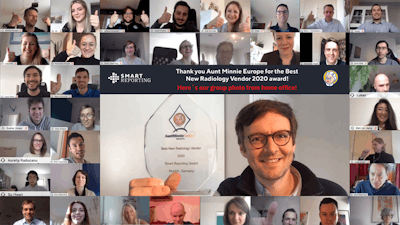 The Smart Reporting team shows its joy over winning the Best New Radiology Vendor award. The trophy is held by Prof. Dr. Wieland Sommer.
The Smart Reporting team shows its joy over winning the Best New Radiology Vendor award. The trophy is held by Prof. Dr. Wieland Sommer.How are you managing your company during the COVID-19 pandemic?
Sommer: Once we saw how quickly COVID-19 cases were rising, we decided on 16 March to encourage everyone to work from home so as to minimize the risk of infection and avoid public transportation. We're a digital startup and already work with a lot of messenger applications and video conferences, such as Slack and Webex, so it was really not so difficult to continue work communications from our home offices, especially given that we already have a fairly flexible working environment and daily virtual meetings with our employees elsewhere in Germany.
In some cases, we were able to offer extra infrastructure, such as computer screens or office chairs, to provide a more comfortable environment at home. Overall, this shift has been pretty efficient for us and I don't have the feeling that so much has changed -- from an engagement and efficiency point of view.
How have you maintained staff morale and ensured everybody stays motivated, productive, and connected?
Of course, it's never the same being unable to have social activities together, but we've tried our best to keep everyone in good spirits and motivated during this time. We have an active company culture where we enjoy having team lunches or after-work beers, so we've tried to make the best of it by keeping regular meetings online using web conferences, chat groups, virtual lunches, coffee breaks, and even after-work video beers. On Fridays, we maintain our weekly tech talks as a way for our team to learn from each other.
One new item during this "quarantine" is that our human resources department has launched a nice internal weekly newsletter that's filled with team updates and health tips that include online classes (yoga, etc.) for people to use while they're at home. I'm pleased that our team is still productive, so we just have to be patient during this time when everything is a bit uncertain.
Have you had to make any changes to how you liaise and communicate with customers?
Yes, we have had to make adjustments in the way we interact with our customers, as many companies have. The biggest change for sales and customer service has been that, unfortunately, we cannot offer meetings in person for the time being and all of our appointments take place online or they have been postponed. At the moment, healthcare systems and staff around the world are facing extraordinary circumstances and many challenges in delivering care.
However, over the past few weeks there has been a spike in interest in our reporting solution, since we launched an initiative to collect guidelines for COVID-19 reporting in radiology. We created a template and made it available for free to any radiologist to use to report chest CT in suspected novel coronavirus cases. It provides a structured approach to report abnormal findings on chest CT, focusing on the different patterns of pulmonary opacities. This template highlights findings that may be associated with COVID-19 affecting the lung.
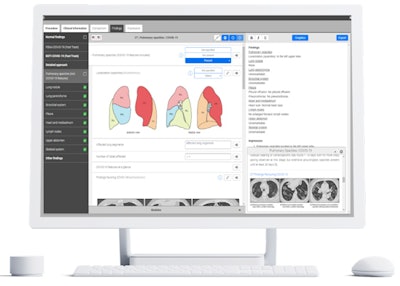 The plan is to update the COVID template regularly and translate it into other languages.
The plan is to update the COVID template regularly and translate it into other languages.As Prof. Dr. Julien Dinkel, professor of thoracic imaging at Ludwig Maximilian University of Munich, explains on our website, symptomatic patients with COVID-19 often show lung abnormalities on their chest CT; in the second week of the infection, the polymerase chain reaction with a nose or throat swab can be false negative in these patients. Chest CT may contribute as a diagnostic and a monitoring tool for COVID-19 pneumonia, and a structured approach and outline of typical COVID-19 features on chest CT may facilitate clinical decision-making.
We have already updated the template twice to include guidelines from the British Society of Thoracic Imaging and the RSNA, and we will translate it into other languages. Many radiologists want to contribute to the project, which is very positive.
What might be the long-term implications/outcome of the COVID-19 crisis for radiology or medicine in general?
The current circumstances have created an opening for telemedicine to find much broader acceptance among clinicians, patients, and ultimately, politicians. This current global crisis will undoubtedly have an impact in terms of how the medical community works in the future. For example, virtual conferences and workshops will become more commonplace, and we're able to see that it's possible to change in-person meetings to video conferences, particularly as we realize the need to reduce travel.
What do you hope to achieve in the next couple of years?
Our priority is to grow as a company. With the expanding clinical content that we are able to offer, we want to grow our product into a worldwide community and a global network of knowledge that is accessible to radiologists from anywhere, anytime. We will have exciting news to share on this in the coming months.
Another focus area is our footprint. Historically, it has been strong in radiology and in German-speaking countries. So, taking the momentum from within those areas, we want to establish the company in the U.K., France, and outside of radiology.
Finally, we want to show that structured reporting and our software is a crucial infrastructural component to establish artificial intelligence (AI) in clinical routine. Building on the many research collaborations and partnerships, we hope to be able to offer the first fully integrated, AI-enhanced image analysis and reporting use cases. All in all, exciting times lie ahead!




